Learn more about the concepts Functions of Python
Download as PPTX, PDF0 likes38 views
Learn more about the concepts Functions of Python
1 of 20
Download to read offline



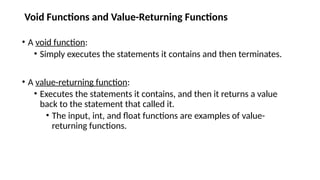

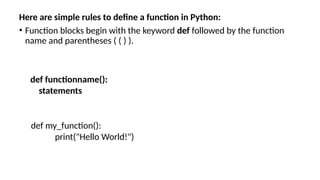

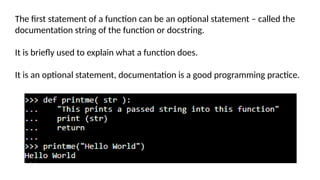
![The code block within every function starts with a colon (:) and is indented.
The statement return [expression] exits a function, optionally passing back
an expression to the caller.
A return statement with no arguments is the same as return None.](https://image.slidesharecdn.com/pythonfunctions-241129040412-b181dbfc/85/Learn-more-about-the-concepts-Functions-of-Python-9-320.jpg)
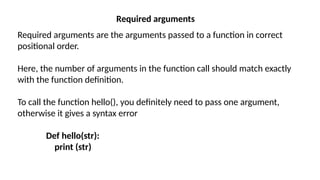




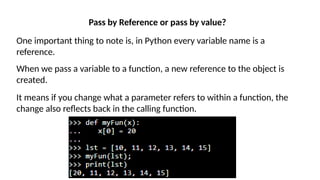
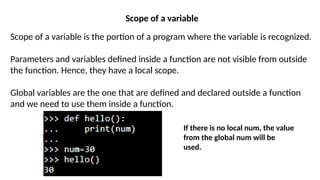




Recommended
All chapters C++ - Copy.pdfyttttttttttttttttttttttttttttt



All chapters C++ - Copy.pdfytttttttttttttttttttttttttttttjacobdiriba
╠²
yesmmmmmmmmmmmmmmmmmmmmmmmmmmmmmmmmmmmmmmmmmmmmmmmmmmmmmmmmmmmmmmmmmmmmmmmmmmmmmmmmmmmmmmmmmmmmmmmmmmmmmmmmmmmmmmmmmmmmmmmmmmmmmmmmmmmmmmmmmmmmmmmmmmmmmmmmmmmmmmmmmmmmmmmmmmmmmmmmmmmmmmmmmmmmmmmmmmmmmmmmmmmmmmmmmmmmmmmmmmmmmmmmmmmmmmmmmmmmmmmmmmmmmmmmmmmmmmmmmmmmmmmmmmmmmmmmmmmmmmmmmmmmmmmmmmmmmmmmmmmmmmmmmmmmmmmmmmmmmmmmmmmmmmmmmmmmmmmmmmmmmmmmmmmmmmmmmmmmmmmmmmmmmmmmmmmmmmmmmmmmmmmmmmmmmmmmmmmmmmmmmmmmmmmmmmmmmmmmmmmmmmmmmmmmmmmmmmmmmmmmmmmmmmmmmmmmmmmmmmmmmmmmmmmmmmmmmmmmmmmmmmmmmmmmmmmmmmmmmmmmmmmmmmmmmmmmmmmmmmmmmmmmmmmmmmmmmmmmmmmmmmmmmmmmmmmmmmmmmmmmmmmmmmmmmmmmmmmmmmmmmmmmmmmmmmmmmmmmmmmmmmmmmmmmmmmmmmmmmmmmmmmmmmmmmmmmmmmmmmmmmmmmmmmmmmmmmmmmmmmmmmmmmmmmmmmmmmmmmmmmmmmmmmmmmmmmmmmmmmklllllllllllllllllllllllllllllllllllllllllllllllllllllllllllllllllllllllllllllllllllllllllllllllllllllllllllllllllljjjjjjjjjjjjjjjjjjjjjjjjjjjjjjjjjjjjjjjjjjjjjjjjjjjjjjjjjjjjjjjjjjjjjjjjjjjjjjjjjjjjjjjjjjjjjjjjjjjjjjjjjjjjjjjjjjjjjjjjjjjjjjjjjjjjjjjjjjjjjjjjjjjjjjjjjjjjjjjjjjjjjjjjjjjjjjjjjjjjjjjjyesmmmmmmmmmmmmmmmmmmmmmmmmmmmmmmmmmmmmmmmmmmmmmmmmmmmmmmmmmmmmmmmmmmmmmmmmmmmmmmmmmmmmmmmmmmmmmmmmmmmmmmmmmmmmmmmmmmmmmmmmmmmmmmmmmmmmmmmmmmmmmmmmmmmmmmmmmmmmmmmmmmmmmmmmmmmmmmmmmmmmmmmmmmmmmmmmmmmmmmmmmmmmmmmmmmmmmmmmmmmmmmmmmmmmmmmmmmmmmmmmmmmmmmmmmmmmmmmmmmmmmmmmmmmmmmmmmmmmmmmmmmmmmmmmmmmmmmmmmmmmmmmmmmmmmmmmmmmmmmmmmmmmmmmmmmmmmmmmmmmmmmmmmmmmmmmmmmmmmmmmmmmmmmmmmmmmmmmmmmmmmmmmmmmmmmmmmmmmmmmmmmmmmmmmmmmmmmmmmmmmmmmmmmmmmmmmmmmmmmmmmmmmmmmmmmmmmmmmmmmmmmmmmmmmmmmmmmmmmmmmmmmmmmmmmmmmmmmmmmmmmmmmmmmmmmmmmmmmmmmmmmmmmmmmmmmmmmmmmmmmmmmmmmmmmmmmmmmmmmmmmmmmmmmmmmmmmmmmmmmmmmmmmmmmmmmmmmmmmmmmmmmmmmmmmmmmmmmmmmmmmmmmmmmmmmmmmmmmmmmmmmmmmmmmmmmmmmmmmmmmmmmmmmmmmmmmmmmmmmmmmmmmmmmmmmmmmmmmmmklllllllllllllllllllllllllllllllllllllllllllllllllllllllllllllllllllllllllllllllllllllllllllllllllllllllllllllllllljjjjjjjjjjjjjjjjjjjjjjjjjjjjjjjjjjjjjjjjjjjjjjjjjjjjjjjjjjjjjjjjjjjjjjjjjjjjjjjjjjjjjjjjjjjjjjjjjjjjjjjjjjjjjjjjjjjjjjjjjjjjjjjjjjjjjjjjjjjjjjjjjjjjjjjjjjjjjjjjjjjjjjjjjjjjjjjjjjjjjjjjyesmmmmmmmmmmmmmmmmmmmmmmmmmmmmmmmmmmmmmmmmmmmmmmmmmmmmmmmmmmmmmmmmmmmmmmmmmmmmmmmmmmmmmmmmmmmmmmmmmmmmmmmmmmmmmmmmmmmmmmmmmmmmmmmmmmmmmmmmmmmmmmmmmmmmmmmmmmmmmmmmmmmmmmmmmmmmmmmmmmmmmmmmmmmmmmmmmmmmmmmmmmmmmmmmmmmmmmmmmmmmmmmmmmmmmmmmmmmmmmmmmmmmmmmmmmmmmmmmmmmmmmmmmmmmmmmmmmmmmmmmmmmmmmmmmmmmmmmmmmmmmmmmmmmmmmmmmmmmmmmmmmmmmmmmmmmmmmmmmmmmmmmmmmmmmmmmmmmmmmmmmmmmmmmmmmmmmmmmmmmmmmmmmmmmmmmmmmmmmmmmmmmmmmmmmmmmmmmmmmmmmmmmmmmmmmmmmmmmmmmmmmmmmmmmmmmmmmmmmmmmmmmmmmmmmmmmmmmmmmmmmmmmmmmmmmmmmmmmmmmmmmmmmmmmmmmmmmmmmmmmmmmmmmmmmmmmmmmmmmmmmmmmmmmmmmmmmmmmmmmmmmmmmmmmmmmmmmmmmmmmmmmmmmmmmmmmmmmmmmmmmmmmmmmmmmmmmmmmmmmmmmmmmmmmmmmmmmmmmmmmmmmmmmmmmmmmmmmmmmmmmmmmmmmmmmmmmmmmmmmmmmmmmmmmmmmmmmmmmmklllllllllllllllllllllllllllllllllllllllllllllllllllllllllllllllllllllllllllllllllllllllllllllllllllllllllllllllllljjjjjjjjjjjjjjjjjjjjjjjjjjjjjjjjjjjjjjjjjjjjjjjjjjjjjjjjjjjjjjjjjjjjjjjjjjjjjjjjjjjjjjjjjjjjjjjjjjjjjjjjjjjjjjjjjjjjjjjjjjjjjjjjjjjjjjjjjjjjjjjjjjjjjjjjjjjjjjjjjjjjjjjjjjjjjjjjjjjjjjjPython functions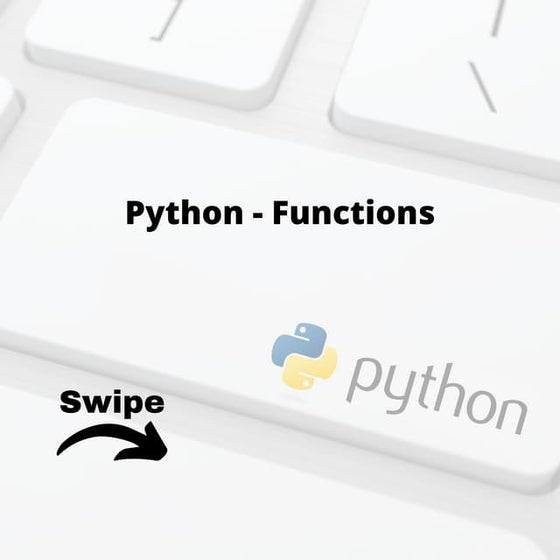



Python functionsLearnbay Datascience
╠²
This presentation educates you about the Functions of the Python, Defining a Function, Calling a Function, Pass by reference vs value, Pass by reference vs value, Required arguments, Keyword arguments, Default arguments and Variable-length arguments.
For more topics stay tuned with Learnbay.04. WORKING WITH FUNCTIONS-2 (1).pptx



04. WORKING WITH FUNCTIONS-2 (1).pptxManas40552
╠²
Functions allow programmers to organize code into reusable units and divide large programs into smaller, more manageable parts. The document discusses key concepts related to functions in Python like defining and calling user-defined functions, passing arguments, scope, and recursion. It provides examples of different types of functions and how concepts like mutability impact parameter passing. Functions are a fundamental part of modular and readable program design.Powerpoint presentation for Python Functions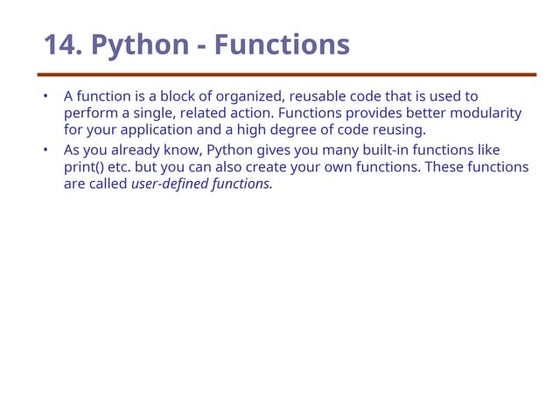



Powerpoint presentation for Python FunctionsBalaSubramanian376976
╠²
Python Functions Descriptions PPTPython-Functions.pptx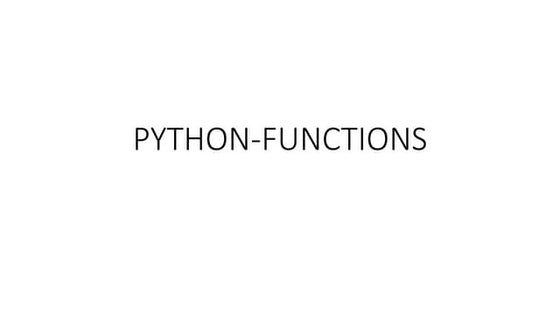



Python-Functions.pptxKarudaiyar Ganapathy
╠²
Functions allow programmers to organize and reuse code. They take in parameters and return values. Parameters act as variables that represent the information passed into a function. Arguments are the actual values passed into the function call. Functions can have default parameter values. Functions can return values using the return statement. Python passes arguments by reference, so changes made to parameters inside functions will persist outside the function as well. Functions can also take in arbitrary or keyword arguments. Recursion is when a function calls itself within its own definition. It breaks problems down into sub-problems until a base case is reached. The main types of recursion are direct, indirect, and tail recursion. Recursion can make code more elegant but uses more memory than iteration.Python programming - Functions and list and tuples



Python programming - Functions and list and tuplesMalligaarjunanN
╠²
- A function is a block of reusable code that takes in parameters, performs an action, and returns a value. Functions provide modularity and code reusability.
- Functions in Python are defined using the def keyword followed by the function name and parameters in parentheses. The code block is indented and can return a value. Parameters can have default values.
- Functions can take positional arguments, keyword arguments, and variable length arguments. Parameters are passed by reference, so changes inside the function also affect the variables outside.
- Anonymous functions called lambdas are small single expression functions defined with the lambda keyword. They do not have a name and cannot contain multiple expressions or statements.Functions and modular programming.pptx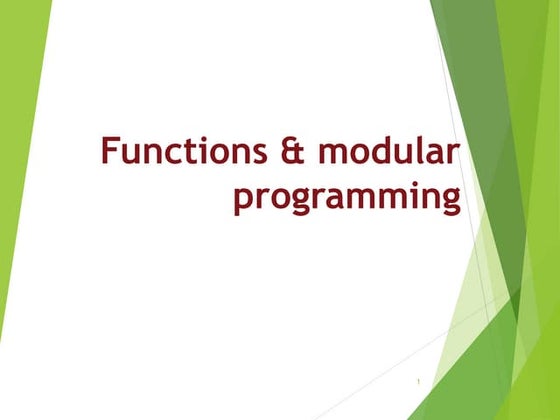



Functions and modular programming.pptxzueZ3
╠²
This document discusses functions and modular programming in C++. It defines what a function is and explains that functions allow dividing code into separate and reusable tasks. It covers function declarations, definitions, parameters, return types, and calling functions. It also discusses different ways of passing arguments to functions: call by value, call by pointer, and call by reference. Finally, it provides an example program that calculates addition and subtraction using different functions called within the main function. Modular programming is also summarized as dividing a program into independent and reusable modules to reduce complexity, decrease duplication, improve collaboration and testing.FUNCTION CPU



FUNCTION CPUKrushal Kakadia
╠²
This document discusses functions in C programming. It defines functions as a group of statements that perform a specific task and have a name. Main functions must be included in every C program as it is where program execution begins. Functions help facilitate modular programming by dividing programs into smaller parts. Functions can be user-defined or built-in library functions. Parameters can be passed to functions by value or by reference. Functions can call themselves through recursion. Variables have different storage classes like auto, register, static, and external that determine scope and lifetime.functions new.pptx



functions new.pptxbhuvanalakshmik2
╠²
The document discusses functions in Python. It introduces functions as a way to divide large programs into smaller, more manageable units called functions. Functions allow code to be reused by calling or invoking the function from different parts of a program. The document then covers key concepts related to functions like arguments, parameters, scope, recursion, and more. It provides examples to illustrate different types of functions and how concepts like scope, recursion, and argument passing work.UNIT 3 python.pptx



UNIT 3 python.pptxTKSanthoshRao
╠²
jnnnnnnnnnnnnnnnnnnnnnnnnnnnnnnnnnnnnnnnnnnnnnnnnnnnnnnnnnnnnnnnnnnnnnnnnnnnnnnnnnnnnnnnnnnnnnnnnnnnnnnnnnnnnnnnnnnnnnnnnnnnnnnnnnnnnnnnnnnnnnnnnnnnnnnnnnnnnnnnnnnnnnnnnnnnnnnnnnnnnnnnnnnnnnnnnnnnnnnnnnnnnnnnnnnnnnnnnnnnnnnnnnnnnnnnnnnnnnnnnnnnnnnnnnnnnnnnnnnnnnnnnnnnnnnnnnnnnnnnnnnnnnnnnnnnnnnnnnnnnnnnnnnnnnnnnnnnnnnnnnnnnnnnnnnnnnnnnnnnnnnnnnnnnnnnnnnnnnnnnnnnnnnnnnnnnnnnnnnnllllllllllllllllllllllllllllllllllllllllllllllllllllllllllllllllllllllllllllllllllllllllllllllllllllllkCh4 functions



Ch4 functionsHattori Sidek
╠²
The document introduces functions in C programming. It discusses defining and calling library functions and user-defined functions, passing arguments to functions, returning values from functions, and writing recursive functions. Functions allow breaking programs into modular and reusable units of code. Library functions perform common tasks like input/output and math operations. User-defined functions are created to perform specific tasks. Information is passed between functions via arguments and return values.functionnotes.pdf



functionnotes.pdfAXL Computer Academy
╠²
Functions allow for code reusability and modularity by defining reusable blocks of code. A function is defined using the def keyword followed by the function name and parameters. Functions can take in arguments and return values. There are different types of arguments like default arguments, keyword arguments, positional arguments, and arbitrary arguments. Functions improve efficiency and reduce errors through code reuse.Python programming variables and comment



Python programming variables and commentMalligaarjunanN
╠²
This document discusses functions in Python. It defines what a function is and provides the basic syntax for defining a function using the def keyword. It also covers function parameters, including required, keyword, default, and variable-length arguments. The document explains how to call functions and discusses pass by reference vs pass by value. Additionally, it covers anonymous functions, function scope, and global vs local variables.3-Python Functions.pdf in simple.........



3-Python Functions.pdf in simple.........mxdsnaps
╠²
Very easy presentation for studying at last moment ¤śģPython Functions.pptx



Python Functions.pptxAnuragBharti27
╠²
The document provides information on Python functions including defining, calling, passing arguments to, and scoping of functions. Some key points covered:
- Functions allow for modular and reusable code. User-defined functions in Python are defined using the def keyword.
- Functions can take arguments, have docstrings, and use return statements. Arguments are passed by reference in Python.
- Functions can be called by name and arguments passed positionally or by keyword. Default and variable arguments are also supported.
- Anonymous lambda functions can take arguments and return an expression.
- Variables in a function have local scope while global variables defined outside a function can be accessed anywhere. The global keyword is used to modify global variables from within a functionPython Functions.pptx



Python Functions.pptxAnuragBharti27
╠²
The document provides information on Python functions including defining, calling, passing arguments to, and scoping of functions. Some key points covered:
- Functions allow for modular and reusable code. User-defined functions in Python are defined using the def keyword.
- Functions can take arguments, have docstrings, and use return statements. Arguments are passed by reference in Python.
- Functions can be called by name and arguments passed positionally or by keyword. Default and variable arguments are also supported.
- Anonymous lambda functions can take arguments and return an expression.
- Variables in a function have local scope while global variables defined outside a function can be accessed anywhere. The global keyword is used to modify global variables from within a functionPython Function.pdf



Python Function.pdfNehaSpillai1
╠²
The document discusses Python functions. It defines functions as reusable blocks of code that can be called anywhere in a program. Some key points covered include:
- Functions allow code reuse and make programs easier to understand by splitting them into logical blocks.
- There are built-in and user-defined functions. User-defined functions are defined using the def keyword followed by the function name and parameters.
- Functions can take arguments, have default values, and return values. They improve readability and maintainability of large Python programs.Functions in C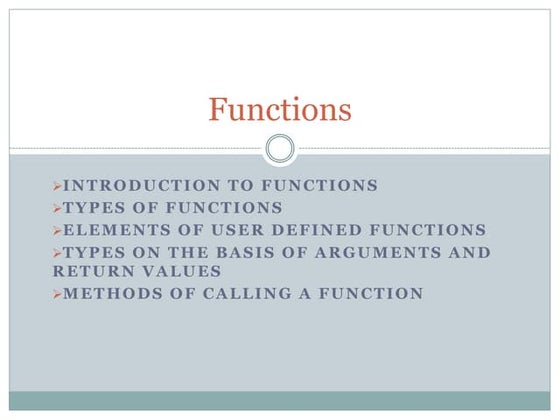



Functions in CKamal Acharya
╠²
This document discusses different types of functions in C programming. It defines library functions, user-defined functions, and the key elements of functions like prototypes, arguments, parameters, return values. It categorizes functions based on whether they have arguments and return values. The document also explains how functions are called, either by value where changes are not reflected back or by reference where the original values are changed.C functions



C functionsUniversity of Potsdam
╠²
A function is a group of statements that together perform a task. Every C program has at least one function, which is main(), and all the most trivial programs can define additional functions. You can divide up your code into separate functions.User defined function in C.pptx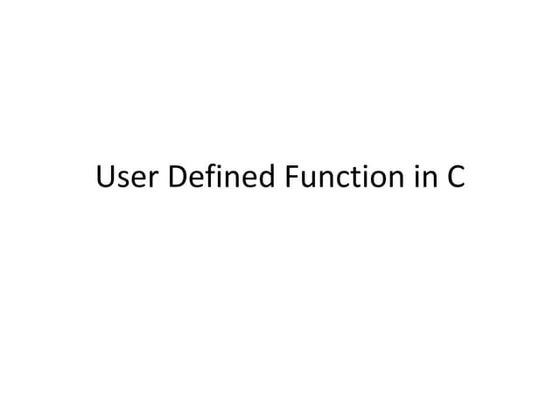



User defined function in C.pptxRhishav Poudyal
╠²
User Defined Function in C
- Functions modularize programs and allow for code reusability. Parameters allow communication between functions.
- A function definition includes a return type, name, parameters, and block of statements. Functions are called within other functions.
- Functions provide benefits like divide and conquer programming, manageable development, and abstraction that hides internal details.Userdefined functions brief explaination.pdf



Userdefined functions brief explaination.pdfDeeptiMalhotra19
╠²
1. The document discusses functions in Python including types of functions, arguments, parameters, scope of variables, and returning values from functions.
2. Functions allow you to organize and reuse code, and in Python are defined using the def keyword. Arguments pass information into a function as variables called parameters.
3. Variables can have local or global scope depending on whether they are defined inside or outside of a function. The global keyword is used to read or write global variables inside a function.Python Functions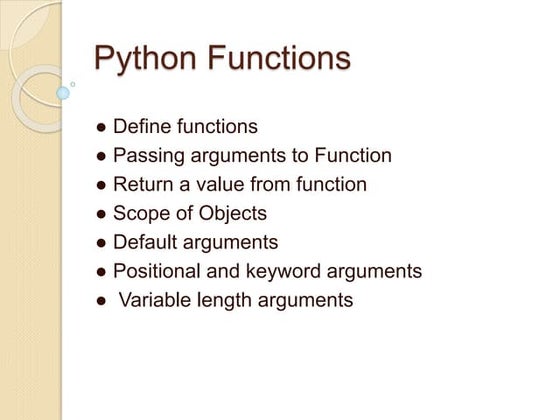



Python FunctionsMohammed Sikander
╠²
Python functions allow for reusable code through defining functions, passing arguments, returning values, and setting scopes. Functions can take positional or keyword arguments, as well as variable length arguments. Default arguments allow functions to specify default values for optional parameters. Functions are objects that can be assigned to variables and referenced later.functions- best.pdf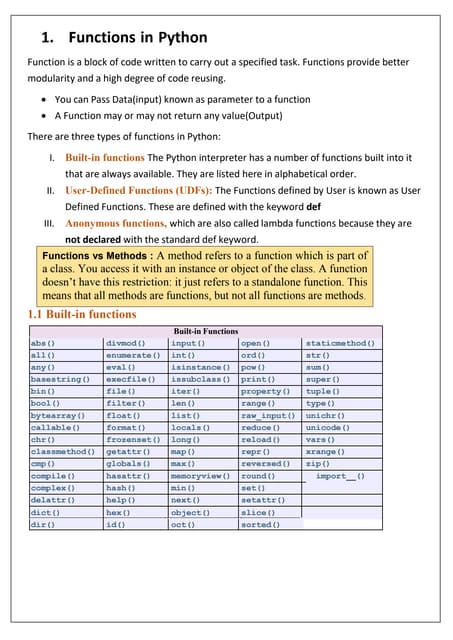



functions- best.pdfMikialeTesfamariam
╠²
The document discusses functions in the Python math module. It provides a list of common mathematical functions in the math module along with a brief description of what each function does, such as ceil(x) which returns the smallest integer greater than or equal to x, copysign(x, y) which returns x with the sign of y, and factorial(x) which returns the factorial of x. It also includes trigonometric functions like sin(x), cos(x), and tan(x), their inverse functions, and functions for exponentials, logarithms, and other common mathematical operations.YSPH VMOC Special Report - Measles Outbreak Southwest US 4-6-2025 ver 5.pptx



YSPH VMOC Special Report - Measles Outbreak Southwest US 4-6-2025 ver 5.pptxYale School of Public Health - The Virtual Medical Operations Center (VMOC)
╠²
A measles outbreak originating in West Texas has been linked to confirmed cases in New Mexico, with additional cases reported in Oklahoma and Kansas. 58 individuals have required hospitalization, and 3 deaths, 2 children in Texas and 1 adult in New Mexico. These fatalities mark the first measles-related deaths in the United States since 2015 and the first pediatric measles death since 2003. The YSPH The Virtual Medical Operations Center Briefs (VMOC) were created as a service-learning project by faculty and graduate students at the Yale School of Public Health in response to the 2010 Haiti Earthquake. Each year, the VMOC Briefs are produced by students enrolled in Environmental Health Science Course 581 - Public Health Emergencies: Disaster Planning and Response. These briefs compile diverse information sources ŌĆō including status reports, maps, news articles, and web contentŌĆō into a single, easily digestible document that can be widely shared and used interactively.Key features of this report include:
- Comprehensive Overview: Provides situation updates, maps, relevant news, and web resources.
- Accessibility: Designed for easy reading, wide distribution, and interactive use.
- Collaboration: The ŌĆ£unlocked" format enables other responders to share, copy, and adapt it seamlessly.
The students learn by doing, quickly discovering how and where to find critical╠²information and presenting╠²it in an easily understood manner.╠²╠²More Related Content
Similar to Learn more about the concepts Functions of Python (20)
FUNCTION CPU



FUNCTION CPUKrushal Kakadia
╠²
This document discusses functions in C programming. It defines functions as a group of statements that perform a specific task and have a name. Main functions must be included in every C program as it is where program execution begins. Functions help facilitate modular programming by dividing programs into smaller parts. Functions can be user-defined or built-in library functions. Parameters can be passed to functions by value or by reference. Functions can call themselves through recursion. Variables have different storage classes like auto, register, static, and external that determine scope and lifetime.functions new.pptx



functions new.pptxbhuvanalakshmik2
╠²
The document discusses functions in Python. It introduces functions as a way to divide large programs into smaller, more manageable units called functions. Functions allow code to be reused by calling or invoking the function from different parts of a program. The document then covers key concepts related to functions like arguments, parameters, scope, recursion, and more. It provides examples to illustrate different types of functions and how concepts like scope, recursion, and argument passing work.UNIT 3 python.pptx



UNIT 3 python.pptxTKSanthoshRao
╠²
jnnnnnnnnnnnnnnnnnnnnnnnnnnnnnnnnnnnnnnnnnnnnnnnnnnnnnnnnnnnnnnnnnnnnnnnnnnnnnnnnnnnnnnnnnnnnnnnnnnnnnnnnnnnnnnnnnnnnnnnnnnnnnnnnnnnnnnnnnnnnnnnnnnnnnnnnnnnnnnnnnnnnnnnnnnnnnnnnnnnnnnnnnnnnnnnnnnnnnnnnnnnnnnnnnnnnnnnnnnnnnnnnnnnnnnnnnnnnnnnnnnnnnnnnnnnnnnnnnnnnnnnnnnnnnnnnnnnnnnnnnnnnnnnnnnnnnnnnnnnnnnnnnnnnnnnnnnnnnnnnnnnnnnnnnnnnnnnnnnnnnnnnnnnnnnnnnnnnnnnnnnnnnnnnnnnnnnnnnnnllllllllllllllllllllllllllllllllllllllllllllllllllllllllllllllllllllllllllllllllllllllllllllllllllllllkCh4 functions



Ch4 functionsHattori Sidek
╠²
The document introduces functions in C programming. It discusses defining and calling library functions and user-defined functions, passing arguments to functions, returning values from functions, and writing recursive functions. Functions allow breaking programs into modular and reusable units of code. Library functions perform common tasks like input/output and math operations. User-defined functions are created to perform specific tasks. Information is passed between functions via arguments and return values.functionnotes.pdf



functionnotes.pdfAXL Computer Academy
╠²
Functions allow for code reusability and modularity by defining reusable blocks of code. A function is defined using the def keyword followed by the function name and parameters. Functions can take in arguments and return values. There are different types of arguments like default arguments, keyword arguments, positional arguments, and arbitrary arguments. Functions improve efficiency and reduce errors through code reuse.Python programming variables and comment



Python programming variables and commentMalligaarjunanN
╠²
This document discusses functions in Python. It defines what a function is and provides the basic syntax for defining a function using the def keyword. It also covers function parameters, including required, keyword, default, and variable-length arguments. The document explains how to call functions and discusses pass by reference vs pass by value. Additionally, it covers anonymous functions, function scope, and global vs local variables.3-Python Functions.pdf in simple.........



3-Python Functions.pdf in simple.........mxdsnaps
╠²
Very easy presentation for studying at last moment ¤śģPython Functions.pptx



Python Functions.pptxAnuragBharti27
╠²
The document provides information on Python functions including defining, calling, passing arguments to, and scoping of functions. Some key points covered:
- Functions allow for modular and reusable code. User-defined functions in Python are defined using the def keyword.
- Functions can take arguments, have docstrings, and use return statements. Arguments are passed by reference in Python.
- Functions can be called by name and arguments passed positionally or by keyword. Default and variable arguments are also supported.
- Anonymous lambda functions can take arguments and return an expression.
- Variables in a function have local scope while global variables defined outside a function can be accessed anywhere. The global keyword is used to modify global variables from within a functionPython Functions.pptx



Python Functions.pptxAnuragBharti27
╠²
The document provides information on Python functions including defining, calling, passing arguments to, and scoping of functions. Some key points covered:
- Functions allow for modular and reusable code. User-defined functions in Python are defined using the def keyword.
- Functions can take arguments, have docstrings, and use return statements. Arguments are passed by reference in Python.
- Functions can be called by name and arguments passed positionally or by keyword. Default and variable arguments are also supported.
- Anonymous lambda functions can take arguments and return an expression.
- Variables in a function have local scope while global variables defined outside a function can be accessed anywhere. The global keyword is used to modify global variables from within a functionPython Function.pdf



Python Function.pdfNehaSpillai1
╠²
The document discusses Python functions. It defines functions as reusable blocks of code that can be called anywhere in a program. Some key points covered include:
- Functions allow code reuse and make programs easier to understand by splitting them into logical blocks.
- There are built-in and user-defined functions. User-defined functions are defined using the def keyword followed by the function name and parameters.
- Functions can take arguments, have default values, and return values. They improve readability and maintainability of large Python programs.Functions in C



Functions in CKamal Acharya
╠²
This document discusses different types of functions in C programming. It defines library functions, user-defined functions, and the key elements of functions like prototypes, arguments, parameters, return values. It categorizes functions based on whether they have arguments and return values. The document also explains how functions are called, either by value where changes are not reflected back or by reference where the original values are changed.C functions



C functionsUniversity of Potsdam
╠²
A function is a group of statements that together perform a task. Every C program has at least one function, which is main(), and all the most trivial programs can define additional functions. You can divide up your code into separate functions.User defined function in C.pptx



User defined function in C.pptxRhishav Poudyal
╠²
User Defined Function in C
- Functions modularize programs and allow for code reusability. Parameters allow communication between functions.
- A function definition includes a return type, name, parameters, and block of statements. Functions are called within other functions.
- Functions provide benefits like divide and conquer programming, manageable development, and abstraction that hides internal details.Userdefined functions brief explaination.pdf



Userdefined functions brief explaination.pdfDeeptiMalhotra19
╠²
1. The document discusses functions in Python including types of functions, arguments, parameters, scope of variables, and returning values from functions.
2. Functions allow you to organize and reuse code, and in Python are defined using the def keyword. Arguments pass information into a function as variables called parameters.
3. Variables can have local or global scope depending on whether they are defined inside or outside of a function. The global keyword is used to read or write global variables inside a function.Python Functions



Python FunctionsMohammed Sikander
╠²
Python functions allow for reusable code through defining functions, passing arguments, returning values, and setting scopes. Functions can take positional or keyword arguments, as well as variable length arguments. Default arguments allow functions to specify default values for optional parameters. Functions are objects that can be assigned to variables and referenced later.functions- best.pdf



functions- best.pdfMikialeTesfamariam
╠²
The document discusses functions in the Python math module. It provides a list of common mathematical functions in the math module along with a brief description of what each function does, such as ceil(x) which returns the smallest integer greater than or equal to x, copysign(x, y) which returns x with the sign of y, and factorial(x) which returns the factorial of x. It also includes trigonometric functions like sin(x), cos(x), and tan(x), their inverse functions, and functions for exponentials, logarithms, and other common mathematical operations.Recently uploaded (20)
YSPH VMOC Special Report - Measles Outbreak Southwest US 4-6-2025 ver 5.pptx



YSPH VMOC Special Report - Measles Outbreak Southwest US 4-6-2025 ver 5.pptxYale School of Public Health - The Virtual Medical Operations Center (VMOC)
╠²
A measles outbreak originating in West Texas has been linked to confirmed cases in New Mexico, with additional cases reported in Oklahoma and Kansas. 58 individuals have required hospitalization, and 3 deaths, 2 children in Texas and 1 adult in New Mexico. These fatalities mark the first measles-related deaths in the United States since 2015 and the first pediatric measles death since 2003. The YSPH The Virtual Medical Operations Center Briefs (VMOC) were created as a service-learning project by faculty and graduate students at the Yale School of Public Health in response to the 2010 Haiti Earthquake. Each year, the VMOC Briefs are produced by students enrolled in Environmental Health Science Course 581 - Public Health Emergencies: Disaster Planning and Response. These briefs compile diverse information sources ŌĆō including status reports, maps, news articles, and web contentŌĆō into a single, easily digestible document that can be widely shared and used interactively.Key features of this report include:
- Comprehensive Overview: Provides situation updates, maps, relevant news, and web resources.
- Accessibility: Designed for easy reading, wide distribution, and interactive use.
- Collaboration: The ŌĆ£unlocked" format enables other responders to share, copy, and adapt it seamlessly.
The students learn by doing, quickly discovering how and where to find critical╠²information and presenting╠²it in an easily understood manner.╠²╠²Using GenAI for Universal Design for Learning



Using GenAI for Universal Design for LearningDamian T. Gordon
╠²
Using GenAI for Universal Design for Learning "The Write Path: Navigating Research Writing, Publication, and Professional G...



"The Write Path: Navigating Research Writing, Publication, and Professional G...neelottama
╠²
To understand the meaning of publication
Enhancing SoTL through Generative AI -- Opportunities and Ethical Considerati...



Enhancing SoTL through Generative AI -- Opportunities and Ethical Considerati...Sue Beckingham
╠²
This presentation explores the role of generative AI (GenAI) in enhancing the Scholarship of Teaching and Learning (SoTL), using FeltenŌĆÖs five principles of good practice as a guiding framework. As educators within higher education institutions increasingly integrate GenAI into teaching and research, it is vital to consider how these tools can support scholarly inquiry into student learning, while remaining contextually grounded, methodologically rigorous, collaborative, and appropriately public.
Through practical examples and case-based scenarios, the session demonstrates how generative GenAI can assist in analysing critical reflection of current practice, enhancing teaching approaches and learning materials, supporting SoTL research design, fostering student partnerships, and amplifying the reach of scholarly outputs. Attendees will gain insights into ethical considerations, opportunities, and limitations of GenAI in SoTL, as well as ideas for integrating GenAI tools into their own scholarly teaching practices. The session invites critical reflection and dialogue about the responsible use of GenAI to enhance teaching, learning, and scholarly impact.
O SWEET SPONTANEOUS BY EDWARD ESTLIN CUMMINGSAN.pptx



O SWEET SPONTANEOUS BY EDWARD ESTLIN CUMMINGSAN.pptxAituzazKoree
╠²
O SWEET SPONTANEOUS
explain
ThemesPurchase Analysis in Odoo 17 - Odoo ║▌║▌▀Żs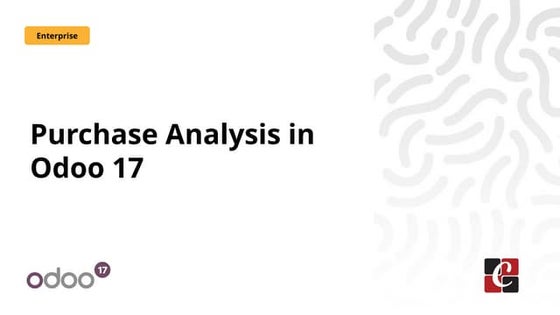



Purchase Analysis in Odoo 17 - Odoo ║▌║▌▀ŻsCeline George
╠²
Purchase is one of the important things as a part of a business. It is essential to analyse everything that is happening inside the purchase and keep tracking. In Odoo 17, the reporting section is inside the purchase module, which is purchase analysis.BUSINESS QUIZ | THE QUIZ CLUB OF PSGCAS | 17TH MARCH 2025 .pptx



BUSINESS QUIZ | THE QUIZ CLUB OF PSGCAS | 17TH MARCH 2025 .pptxQuiz Club of PSG College of Arts & Science
╠²
The Quiz club of PSGCAS brings you another fun-filled trivia ride. Presenting you a Business quiz with 20 sharp questions to feed your intellectual stimulus. So, sharpen your business mind for this quiz set
Quizmaster: Thanvanth N A, BA Economics, The Quiz Club of PSG College of Arts & Science (2023-26 batch)The Effectiveness of Manual Therapies on the Thoracic.pptx



The Effectiveness of Manual Therapies on the Thoracic.pptxSamarHosni3
╠²
The Effectiveness of Manual Therapies on the Thoracic.pptxT├ĆI LIß╗åU CHUY├ŖN S├éU Lß╗ÜP 12 THEO CHŲ»ŲĀNG TR├īNH Mß╗ÜI D├ÖNG CHO Cß║ó 3 Bß╗ś S├üCH ├öN THI...



T├ĆI LIß╗åU CHUY├ŖN S├éU Lß╗ÜP 12 THEO CHŲ»ŲĀNG TR├īNH Mß╗ÜI D├ÖNG CHO Cß║ó 3 Bß╗ś S├üCH ├öN THI...Nguyen Thanh Tu Collection
╠²
https://app.box.com/s/p7hp81fb1v6kpk0a46zxmojf3ehi7yg2IB-Unit-4 BBA BVIMR 2022 Syllabus_watermark.pdf



IB-Unit-4 BBA BVIMR 2022 Syllabus_watermark.pdfDr. Mahtab Alam
╠²
International Business BBA 4 as per Syllabus CBCS 2022 of Bharati Vidyapeeth (Deemed to be University)Synthesis for VIth SEM 21-2-25.pptx by Mrs. Manjushri P. Dabhade



Synthesis for VIth SEM 21-2-25.pptx by Mrs. Manjushri P. DabhadeDabhade madam Dabhade
╠²
Synthesis of drugsnature and importance of Indian Knowledge System



nature and importance of Indian Knowledge Systemhanishabatra0
╠²
it depicts the nature and importance of Indian Knowledge systemStrategic Corporate Social Responsibility: Sustainable Value Creation Fourth



Strategic Corporate Social Responsibility: Sustainable Value Creation Fourthkeileyrazawi
╠²
Strategic Corporate Social Responsibility: Sustainable Value Creation Fourth
Strategic Corporate Social Responsibility: Sustainable Value Creation Fourth
Strategic Corporate Social Responsibility: Sustainable Value Creation FourthHow to Invoice Shipping Cost to Customer in Odoo 17



How to Invoice Shipping Cost to Customer in Odoo 17Celine George
╠²
Odoo allows the invoicing of the shipping costs after delivery and this ensures that the charges are accurate based on the real time factors like weight, distance and chosen shipping method.Pushyabhuti Dynesty Vardhan Vamsha Early Rulers.pptx



Pushyabhuti Dynesty Vardhan Vamsha Early Rulers.pptxArya Mahila P. G. College, Banaras Hindu University, Varanasi, India.
╠²
Srikanth Bana describes a district named Srikanth in his Harshcharit. It included the modern Delhi and Haryana regions. This district was very prosperous and happy. But Hiuen Tsang criticizes the residents here. According to him, they were superstitious, narrow-minded and intolerant. It seems that non-Buddhist residents were in majority in Srikanth district. Hiuen Tsang has termed the religious beliefs of these residents as superstition, narrow-mindedness and intolerant.Unit No 4- Chemotherapy of Malignancy.pptx



Unit No 4- Chemotherapy of Malignancy.pptxAshish Umale
╠²
In the Pharmacy profession there are many dangerous diseases from which the most dangerous is cancer. Here we study about the cancer as well as its treatment that is supportive to the students of semester VI of Bachelor of Pharmacy. Cancer is a disease of cells of characterized by Progressive, Persistent, Perverted (abnormal), Purposeless and uncontrolled Proliferation of tissues. There are many types of cancer that are harmful to the human body which are responsible to cause the disease condition. The position 7 of guanine residues in DNA is especially susceptible. Cyclophosphamide is a prodrug converted to the active metabolite aldophosphamide in the liver. Procarbazine is a weak MAO inhibitor; produces sedation and other CNS effects, and can interact with foods and drugs. Methotrexate is one of the most commonly used anticancer drugs. Methotrexate (MTX) is a folic acid antagonist. 6-MP and 6-TG are activated to their ribonucleotides, which inhibit purine ring biosynthesis and nucleotide inter conversion. Pyrimidine analogue used in antineoplastic, antifungal and anti psoriatic agents.
5-Fluorouracil (5-FU) is a pyrimidine analog. It is a complex diterpin taxane obtained from bark of the Western yew tree. Actinomycin D is obtained from the fungus of Streptomyces species. Gefitinib and Erlotinib inhibit epidermal growth factor receptor (EGFR) tyrosine kinase. Sunitinib inhibits multiple receptor tyrosine kinases like platelet derived growth factor (PDGF) Rituximab target antigen on the B cells causing lysis of these cells.
Prednisolone is 4 times more potent than hydrocortisone, also more selective glucocorticoid, but fluid retention does occur with high doses. Estradiol is a major regulator of growth for the subset of breast cancers that express the estrogen receptor (ER, ESR1).
Finasteride and dutasteride inhibit conversion of testosterone to dihydrotestosterone in prostate (and other tissues), have palliative effect in advanced carcinoma prostate; occasionally used. Chemotherapy in most cancers (except curable cancers) is generally palliative and suppressive. Chemotherapy is just one of the modes in the treatment of cancer. Other modes like radiotherapy and surgery are also employed to ensure 'total cell kill'.YSPH VMOC Special Report - Measles Outbreak Southwest US 4-6-2025 ver 5.pptx



YSPH VMOC Special Report - Measles Outbreak Southwest US 4-6-2025 ver 5.pptxYale School of Public Health - The Virtual Medical Operations Center (VMOC)
╠²
BUSINESS QUIZ | THE QUIZ CLUB OF PSGCAS | 17TH MARCH 2025 .pptx



BUSINESS QUIZ | THE QUIZ CLUB OF PSGCAS | 17TH MARCH 2025 .pptxQuiz Club of PSG College of Arts & Science
╠²
T├ĆI LIß╗åU CHUY├ŖN S├éU Lß╗ÜP 12 THEO CHŲ»ŲĀNG TR├īNH Mß╗ÜI D├ÖNG CHO Cß║ó 3 Bß╗ś S├üCH ├öN THI...



T├ĆI LIß╗åU CHUY├ŖN S├éU Lß╗ÜP 12 THEO CHŲ»ŲĀNG TR├īNH Mß╗ÜI D├ÖNG CHO Cß║ó 3 Bß╗ś S├üCH ├öN THI...Nguyen Thanh Tu Collection
╠²
Pushyabhuti Dynesty Vardhan Vamsha Early Rulers.pptx



Pushyabhuti Dynesty Vardhan Vamsha Early Rulers.pptxArya Mahila P. G. College, Banaras Hindu University, Varanasi, India.
╠²
Learn more about the concepts Functions of Python
- 2. In Python, a function is a group of related statements that performs a specific task. Functions help break our program into smaller and modular chunks. They take inputs, do some specific computation and produces output. These are logical functional blocks of code that can be reused independently from the main program. Python provides built-in functions like print(), etc. but we can also create your own functions. These functions are called user-defined functions.
- 3. Benefits of Modularizing a Program with Functions ŌĆó The benefits of using functions include: ŌĆó Simpler code ŌĆó Code reuse ŌĆó write the code once and call it multiple times ŌĆó Better testing and debugging ŌĆó Can test and debug each function individually ŌĆó Faster development ŌĆó Easier facilitation of teamwork ŌĆó Different team members can write different functions
- 4. Void Functions and Value-Returning Functions ŌĆó A void function: ŌĆó Simply executes the statements it contains and then terminates. ŌĆó A value-returning function: ŌĆó Executes the statements it contains, and then it returns a value back to the statement that called it. ŌĆó The input, int, and float functions are examples of value- returning functions.
- 5. Defining and Calling a Function ŌĆó Functions are given names ŌĆó Function naming rules: ŌĆó Cannot use key words as a function name ŌĆó Cannot contain spaces ŌĆó First character must be a letter or underscore ŌĆó All other characters must be a letter, number or underscore ŌĆó Uppercase and lowercase characters are distinct
- 6. Here are simple rules to define a function in Python: ŌĆó Function blocks begin with the keyword def followed by the function name and parentheses ( ( ) ). def functionname(): statements def my_function(): print("Hello World!")
- 7. Any input parameters or arguments should be placed within these parentheses. You can also define parameters inside these parentheses. These are optional. def function_name(parameter): statements return def greet(name): print("Hello, " + name + ". Good morning!") >>> greet(ŌĆśNaman')
- 8. The first statement of a function can be an optional statement ŌĆō called the documentation string of the function or docstring. It is briefly used to explain what a function does. It is an optional statement, documentation is a good programming practice.
- 9. The code block within every function starts with a colon (:) and is indented. The statement return [expression] exits a function, optionally passing back an expression to the caller. A return statement with no arguments is the same as return None.
- 10. Required arguments Required arguments are the arguments passed to a function in correct positional order. Here, the number of arguments in the function call should match exactly with the function definition. To call the function hello(), you definitely need to pass one argument, otherwise it gives a syntax error Def hello(str): print (str)
- 11. A default argument is an argument that assumes a default value if a value is not provided in the function call for that argument. We can provide a default value to an argument by using the assignment operator (=). Default Arguments:
- 12. Keyword arguments Keyword arguments are related to the function calls. When you use keyword arguments in a function call, the caller identifies the arguments by the parameter name. This allows us to place them out of order because the Python interpreter is able to use the keywords provided to match the values with parameters.
- 13. Arbitrary Arguments Sometimes, we do not know in advance the number of arguments that will be passed into a function. Python allows us to handle this kind of situation through function calls with an arbitrary number of arguments. In the function definition, we use an asterisk (*) before the parameter name to denote this kind of argument.
- 15. Pass by Reference or pass by value? One important thing to note is, in Python every variable name is a reference. When we pass a variable to a function, a new reference to the object is created. It means if you change what a parameter refers to within a function, the change also reflects back in the calling function.
- 16. Scope of a variable Scope of a variable is the portion of a program where the variable is recognized. Parameters and variables defined inside a function are not visible from outside the function. Hence, they have a local scope. Global variables are the one that are defined and declared outside a function and we need to use them inside a function. If there is no local num, the value from the global num will be used.
- 17. If a variable with the same name is defined inside the scope of function as well then it will print the value given inside the function only and not the global value.
- 19. Split Function
- 20. Calculate the length of the word using len() function. If the length is even, then print the word.








